European expansion to the east
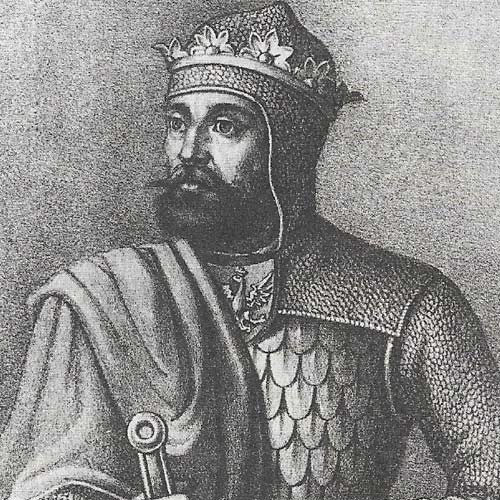
Figure 1. Boleslav the Mighty was the founder of the first Polish monarchy. His reign resulted in 30 years of internal consolidation for his country, the building of a national Polish Christian Church and significant expansion abroad. All of these developments changed Poland from an alliance of Slav tribes into a powerful, centralized monarchy. Alliances with Bohemia, Hungary and Kiev enabled the king to make the Oder and the Vistula virtually Polish rivers and also allowed him to declare war on Emperor Henry II (973–10241 between 1004 and 1008. The emperor finally recognized the integrity of the Polish state and Boleslav was crowned in 1024.
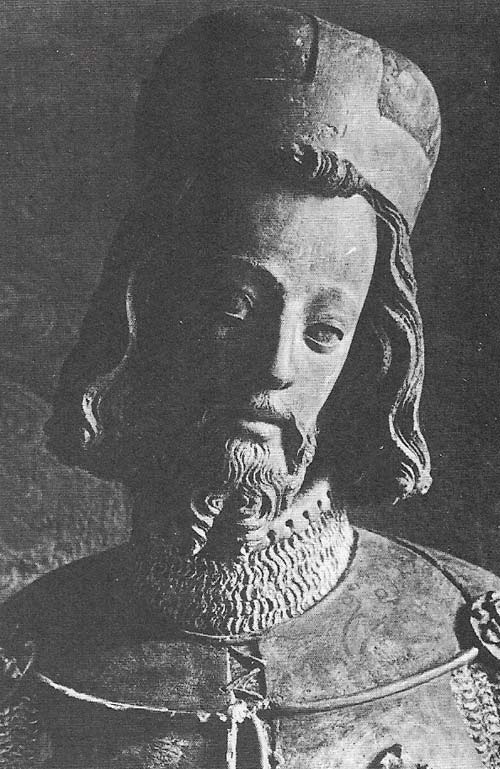
Figure 2. St Wenceslas, Duke of Bohemia and an enthusiastic Christian convert, became the patron saint of Hungary, Poland, and Bohemia. As duke he failed to resist the aggression of the German king Henry I (r. 919–936),who meant to subdue the Wends and Slavs as well as the Bohemians. Bohemia became a German fief (owing nominal allegiance to the emperor) and Wencelas, who was blamed for the defeat, was murdered by his brother, Boleslav (who succeeded him as Boleslav I).
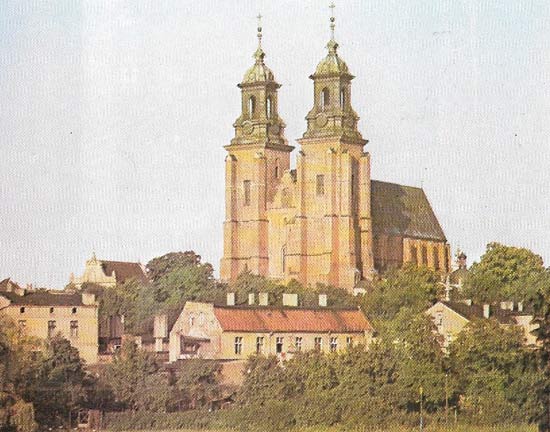
Figure 3. The cathedral of Gniezno (Gnesen) was the center of the Christian religion of the new Polish state. It housed the relics of St Adalbert of Prague, one of the apostles of Eastern Europe. Gniezno, an ancient Polish center, was the most important of the castle towns of Boleslav the Mighty. These towns were thriving garrisons which gradually fostered local trade and finally became centers for the export of corn to the west.
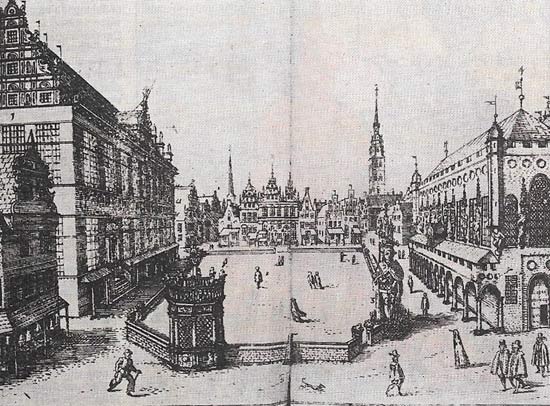
Figure 4. Bremen, on the Weser, is one of the great north German trading ports. Founded in the 9th century by Charlemagne, its merchants set up the city of Riga in 1158 and in 1358 joined the Hansa for protection.
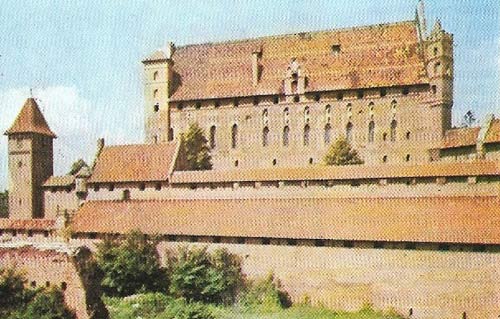
Figure 5. Marienberg, with its famous castle, was the capital of the Teutonic Knights in Prussia. The knights, founded as a noble military, charitable, and missionary organization in 1190, abandoned work in the Holy Land and settled on the Baltic coast to enforce the conversion of the pagan Prussians. In 1309 they established their headquarters in Marienburg.
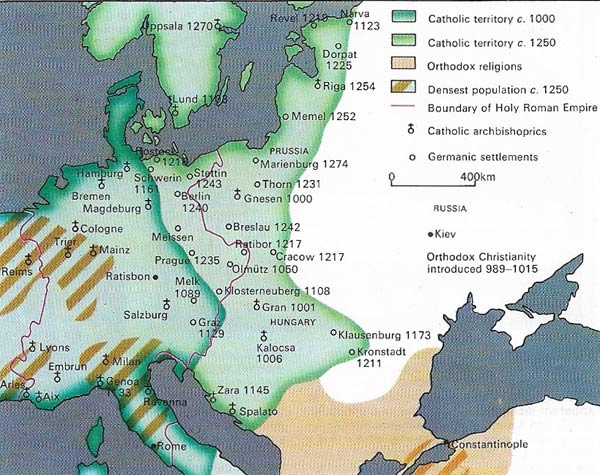
Figure 6. The advance of Christianity in Eastern Europe (1000–1250), and the conversion of the Slavs and Magyars, was quick on a superficial level, but thorough Christianization took centuries. First came the German or Byzantine missionaries, whose real purpose was to convert the rulers and establish bishoprics; only later, in the twelfth century, did Christianity begin to reach the rural communities.
In the centuries before AD 1000, while a lively, enterprising society was emerging in the villages and towns of Western Europe, Eastern Europe was a land of sparsely occupied forests, grasslands and low, easily crossed mountains through which passed at random a variety of peoples. The roaming shepherds of the Carpathians, the nomads from the south Russian steppe who settled in the Danube basin, and the forest peoples of the Vistula (ancestors respectively of the modern Romanians, Hungarians and Poles) travelled up and down the region between the Baltic and the Danube, the Pripet Marshes and the Elbe. They were untouched either by the political or the religious allegiances of the settled lands to the west and south and were impervious even to the cultures of each other. The forest peoples, Polish and Czech Slays, seem to have been divided into numerous 'tribes and many of the grody – fortified settlements on hills or marsh islands which were their capitals – have been uncovered. The grasslands of the middle Danube were the haunts of successive nomadic peoples who lived by raiding neighboring lands. The last ones, the fierce Magyars of mixed Finnish and Turkish origin, reached the area by the late 9th century.
The spread of German influence
To the west of these peoples were the Germans, whose national identity was also recent. Their relations with the Slays were close, sometimes hostile but often peaceful; their society of well-organized communities and their Christian civilization, contained within the Holy Roman Empire, exercised a constant and fruitful pressure. Under the powerful Ottonian kings (919–1024; emperors from 962) the German advance was rapid and for the first time there is evidence that the tribes, in their turn, were beginning to unite: by 1000 the Magyars (whose raids were checked by the German victory at the Lechfeld in 955), the Bohemians and the Poles (Figure 1) had each united under single, independent dynasties. The earliest sign of the evolution was the advance of Christianity (Figure 6). Already in the ninth century Byzantine missionaries converted the Moravians, whose mushroom empire was annihilated by the Magyars; in its place, under German influence, there grew up the Czech duchy of Bohemia, whose first ruler, St Wenceslas (c. 907–929), became a Christian and a tributary of the German king.
Bohemia under German auspices was the focus for the rapid development of all Eastern Europe. Duke Boleslav I (reigned 929–963) was the father-in-law of the first Polish duke, Mieszko I (reigned 963–992), who received Christianity at his hands; while the influence of St Adalbert, Bishop of Prague (Figure 3), caused the Hungarian Duke Stephen (reigned 997–1038) to be baptized. But German influence was ambivalent. In AD 1000 the Polish duke Boleslav the Mighty (c. 996–1025) (Figure 1) received a crown from the emperor and Stephen, who ended the influence of Eastern Christianity in Hungary, received a crown from the pope.
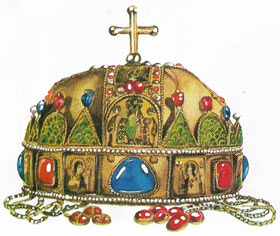 |
| Pope Sylvester II gave St Stephen the upper part of the crown of St Stephen, symbol of the Hungarian nationhood, in 1000. The circlet was given by the Byzantine emperor Michael VII 75 years later. |
The emergence of national identities
In the 11th century the Bohemians, Poles and Hungarians held their own and they acquired a sense of national identity under native dynasties. The Premyslids of Bohemia did not receive the royal title until 1198, but although they were included in the German Empire they retained intact their Slavonic language and customs.
The Polish dynasty of Piast was more aggressively anti-German and their court at Gniezno became the focus of resistance to the ambitions of the Salian emperors. But the unity of their vast territories was superficial and from 1079 to the end of the thirteenth century the country was ruled jointly by, and then divided among, several Piast princes. Throughout this period the unity and identity of the Poles was maintained only by a national Church and a common culture.
The Hungarian house of Arpad was more fortunate in maintaining its unity in close relation with the German emperors and Hungary flourished as a bridge between Byzantium, Russia and western Europe.
Later German migration
The eastward advance of the Germanic peoples had been checked after 1002 short of Pomerania, Poland and Hungary; after 1100 it resumed in force. Slavonic and Magyar rulers welcomed the Germans as cultivators of the sparsely inhabited soil. First came merchants, to swell the Wendish, Polish and Bohemian towns, especially Lubeck and Danzig on the Baltic. A massive migration of farmers followed in the 12th century: they occupied the fertile lands of Silesia, spread throughout Bohemia and parts of Hungary and pioneered the opening up of Transylvania. Finally came the knights, ostensibly to convert the pagan Lithuanians to Christianity, but also to carve out new territories along the Baltic.
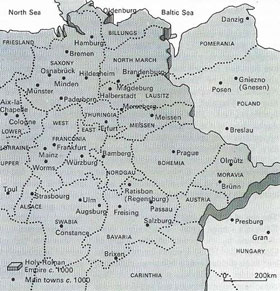 |
Several military orders were formed which in 1237 united as the Order of the Teutonic Knights of Livonia. This heralded German domination of the Baltic and the maritime communities soon founded an association, or Hansa (Figure 4). The Hansa played the predominant role culturally and politically in northeastern Europe. But German rule did not accompany the migration; apart from Polish friction with the Teutonic Knights, relations with the new settlers were generally friendly and mutually profitable.
